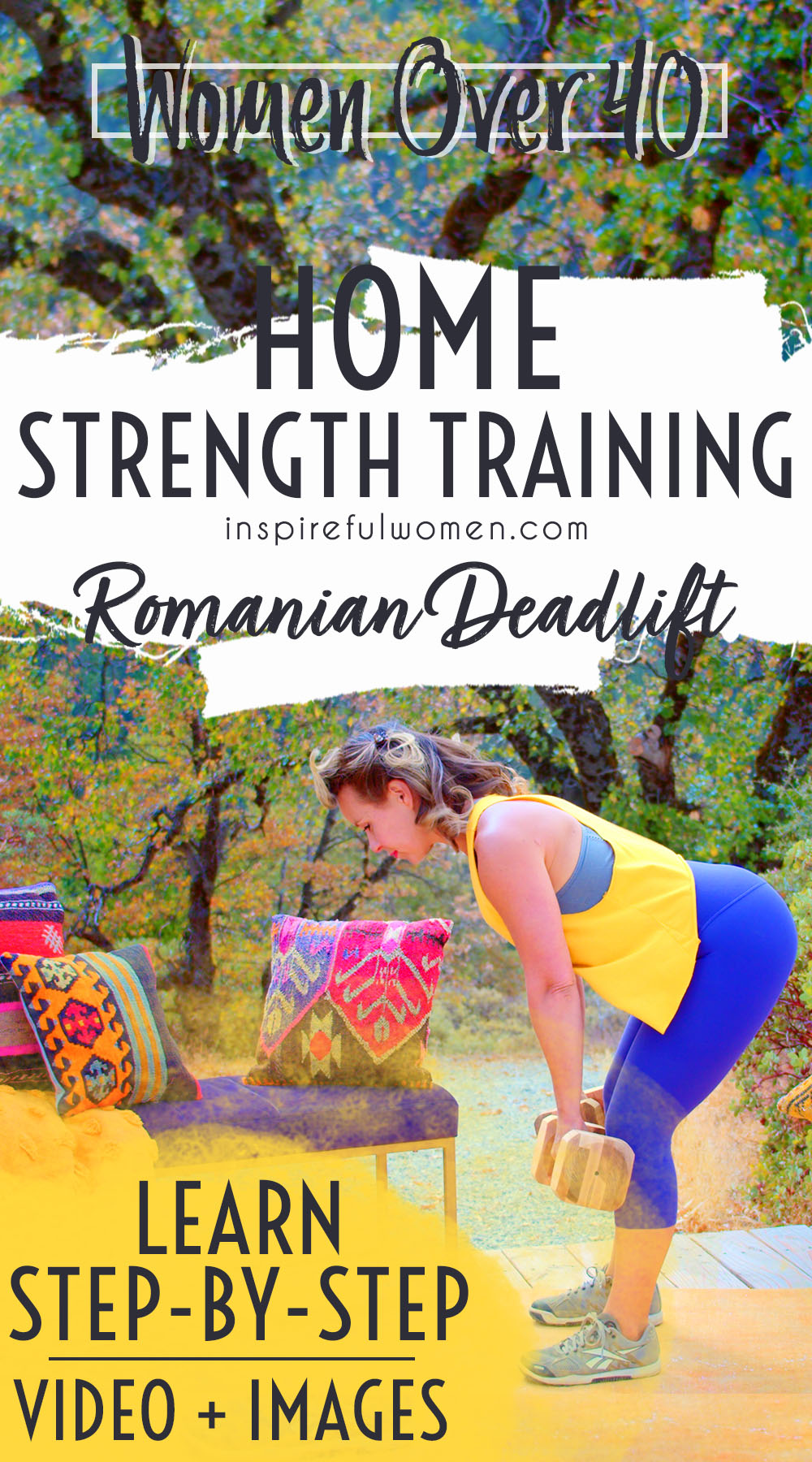Romanian Deadlift
How to Do the Romanian Deadlift - Dumbbells | In-Depth Guide [VISUAL LEARNERS] Beginner
Proper Form, Common Mistakes, & Variations | Home Resistance Training
WHAT DO YOU WANT TO SEE?
QUICK DEMO
QUICK DEMO
MUSCLES THIS WORKS
MUSCLES
MAIN MUSCLES WORKED IN the Romanian Deadlift
GLUTEUS MAXIMUS, QUADRICEPS, AND HAMSTRINGS
OTHER MUSCLES WORKED:
- Adductor magnus
- Gastrocnemius
- Soleus
- Erector spinae
- Lats
- Quadratus lumborum
- Transverse abdominis
STARTING POINTERS
Starting Pointers
WHAT WE'RE DOING TODAY
Other names for this exercise: Straight Leg Deadlift
ALL WE'RE DOING:
A simple bending over at the hips and then standing up again.
The Romanian Deadlift (RDL) is a classic exercise that strengthens your hamstrings and improves your posterior chain. By using dumbbells in the RDL, you can perform this effective movement right in the comfort of your own home.
For this movement, focus on getting form well in place, and then just know for this movement to actually build muscle, you will either need to get some heavy dumbbells to do it with (ie we're talking 25lbs-40lbs + PER hand) OR move on to the Single Leg Romanian Deadlift which will make you work a lot harder without having to hold very heavy weights. That's because these are big muscles- we need enough resistance to challenge them to a level that will actually build muscle & strengthen them.
The Romanian deadlift is slightly different from the standard deadlift because it’s allll about bending at the hip joint and not much else. Standard deadlifts involve lifting by bending at the knee and ankle in addition to the hip joint. Bending at the knee and ankle will work the muscles on the front of the thigh (quadriceps) and the calf muscles.
The Romanian Deadlift is a single joint movement, the hips. The knees are slightly bent throughout the exercise but they do not move, and all of the movement happens at the hips. The focus is on strong hip extension - pulling the hips forward, emphasizing strengthening the gluteus maximus, hamstrings, and adductor magnus muscles.
I personally feel this is the best type of deadlift to begin with, for two reasons - one, because there is only purposeful movement at your hips & nowhere else, it’s easier/simpler to learn the proper form, and two, this type of deadlift works your glutes & hamstrings better while minimizing our quads, which helps a common muscle imbalance many of us have.
Additional notes from Carol the physical therapist: The main difference between a Romanian deadlift and a regular deadlift is that in a regular deadlift, you bend more at the knees at the bottom of the movement, and in the Romanian version you keep your legs straighter - the difference in how this trains your body differently is….. believe the RDL (Romanian Deadlift) allows more concentration on working the hip extensors. The regular deadlift is so quad-dominant that sometimes the hip extensor component almost happens passively, just the momentum of the movement initiated by the quads extending the knees. I almost feel like the hip extension is an afterthought and not the main event, like the calves (I am not really aware of them working I just know that they must be in order to move at the ankle).
The Romanian deadlift is great for isolated hip hinging and strong hip extensor activity. The rep begins in the standing position, the hips bend and the torso leans over from vertical towards horizontal and back up again to complete the rep. When you hinge at the hips you will only be able to go so far before your low back wants to round, or your hamstrings hold you back. When you reach the point that you cannot keep your spine neutral, the gluteus maximus and hamstrings contract to pull your hips forward to stand up tall again. Since there is no movement at the knees and ankles, those muscles are not involved, except to help stabilize the ankle and knee joints.
The Romanian Deadlift targets the gluteus maximus which is one of the most powerful muscles in the body. This exercise places a strong focus on training the strength and power of the gluteus maximus and hamstring muscles by isolating the movement to the hip joints. Strong gluteus maximus muscles help to protect your back from injury - they are doing the work so that the back muscles just need to hold the spine still. This is a one-joint exercise – all of the movement should occur at the hip joints. The “hip” is the joint that is formed between the pelvis and the upper leg (femur), a large ball and socket joint designed for a lot of movement and power. As opposed to the joints of the spine which are designed for stability and support with a minimal amount of movement.
HOW TO DO THE EXERCISE
LOOKS
HOW Romanian Deadlifts SHAPE OUR BODY
Tones and shapes buttocks, front and back of thigh.
PROPER FORM
PROPER FORM: Romanian Deadlift
EQUIPMENT, SETS & REPS
EQUIPMENT
SUGGESTED STARTING WEIGHT FOR WOMEN:
8-10 pounds in each hand.
SETS & REPS:
2 sets of 8 reps.
PACE:
Slow and controlled. Can lift up quicker and lower more slowly.
BODY POSITION
BODY POSITION FOR THE Romanian Deadlift
FEET: Feet placement: Stand with feet hip width apart. Toes forward.
LEGS: Knees are soft with a slight bend.
BODY STANCE: Neutral spine (includes neck). Lift sternum, move your shoulder blades down (this will help engage your lat muscles (latissimus dorsi) which helps support the lumbar spine) and inward (to protect the shoulder joints) and gently activate your core muscles to maintain a neutral spine throughout the exercise.
ARMS: At your sides or in front of your thighs whichever is most comfortable. It is common for people to start with their arms at their sides and then let their arms move forward to the front of the thighs as they hinge forward, that is fine it should feel comfortable and natural. Keep your hands close to your legs.
HAND/GRIP: Holding one dumbbell in each hand. Grip: if your arms are by the sides of your legs, your thumb will point forward. If your hands move to the front of your thighs your thumbs will point in.
HOW TO DO
HOW TO DO Romanian Deadlifts
CUE: You will feel like you are pushing your bottom back as you hinge at your hips. Think of putting distance between your head and your hips.
Hinge forward, keeping your shins vertical. Your torso will go from upright headed towards parallel with the ground (although you will not be reaching full parallel, but your torso will definitely be leaned far over from the hip joint). Continue to push your hips back to hinge at the hips, not bending more at your knees, until you feel a pull or tightness in your hamstrings or you are unable to keep your spine in a neutral position ( rounding of the low back)
Reverse the movement by pressing your feet down into the floor and contracting your gluteus maximus and hamstrings to pull your hips forward. Concentrate on moving through your hips only - remember that this is a one-joint exercise - the movement comes from your hips not your knees or your back. Your hips will straighten (extension), and your torso will return to an upright position - shoulders stacked over hips, over knees and ankles. Your spine should be in neutral throughout the exercise - no bending your low back forward or backwards, sternum lifted.
Hinge forward to start the next rep.
HOW TO SAFELY GET OUT OF THE EXERCISE
Hip hinge until hands are at knee joint line, bend knees to lower weight to floor.
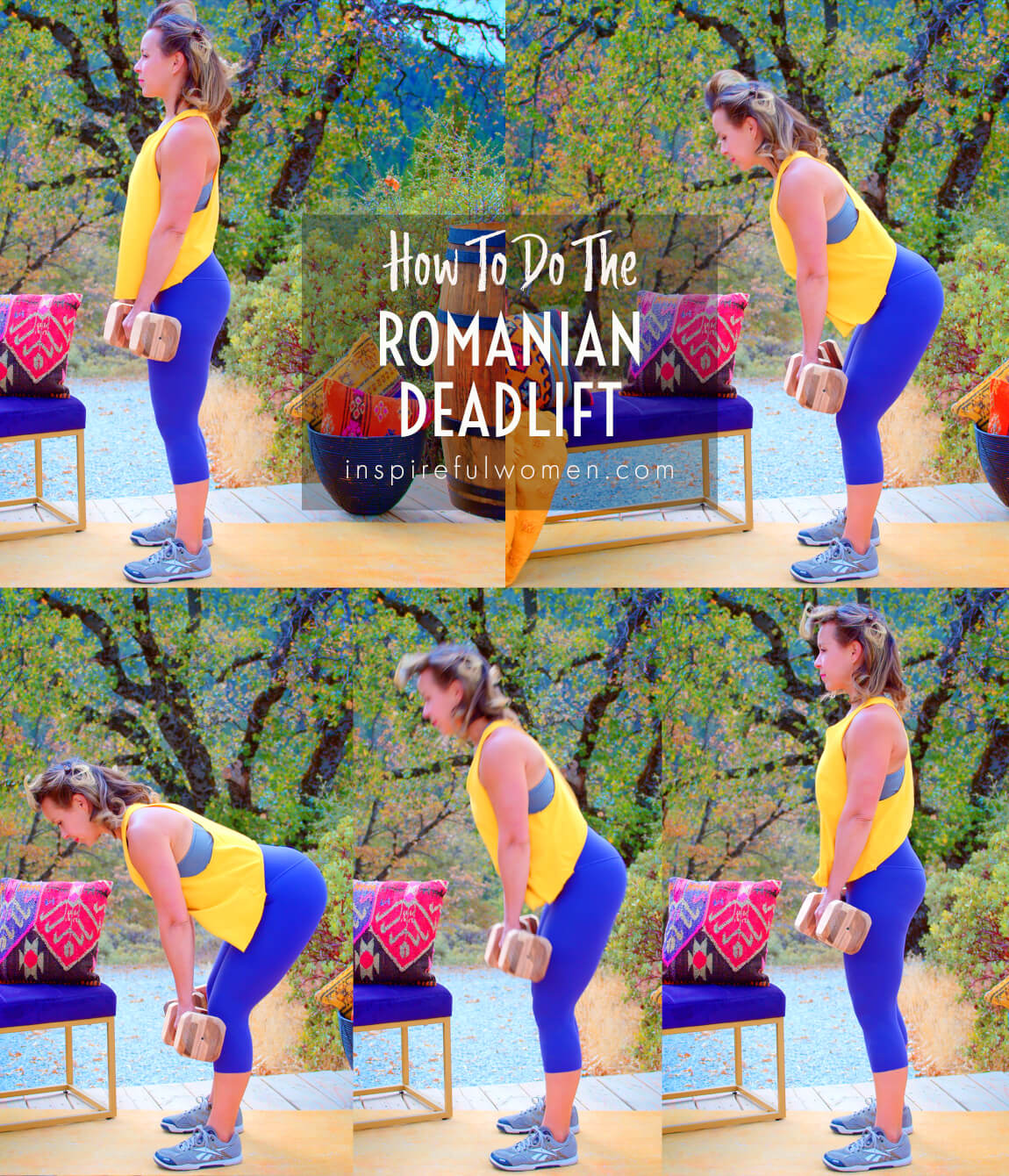
COMMON MISTAKES
COMMON MISTAKES
WHAT TO AVOID WITH THE Romanian Deadlift
KEY TIP:
Guess what? Good news! Many avoids are the same for most movements. Once you learn the basics, there's really only a few extra avoids for each individual movement.
1. Avoid Rounding Spine
AVOID: Avoid rounding the back.
WHY NOT?
- This is mostly just a habit developed from years of using your back to lift.
- This can also happen when you use too much weight. (This would be the crowbar example - or the fishing pole. You only can lift the weight without injury if the back muscles are strong enough to hold the back in a safe position.)
WHAT TO DO:
- Begin with no weight or lighter weight and just practice your form, add weight slowly.
- Keep your sternum lifted and your abdominals engaged to help keep your spine neutral.
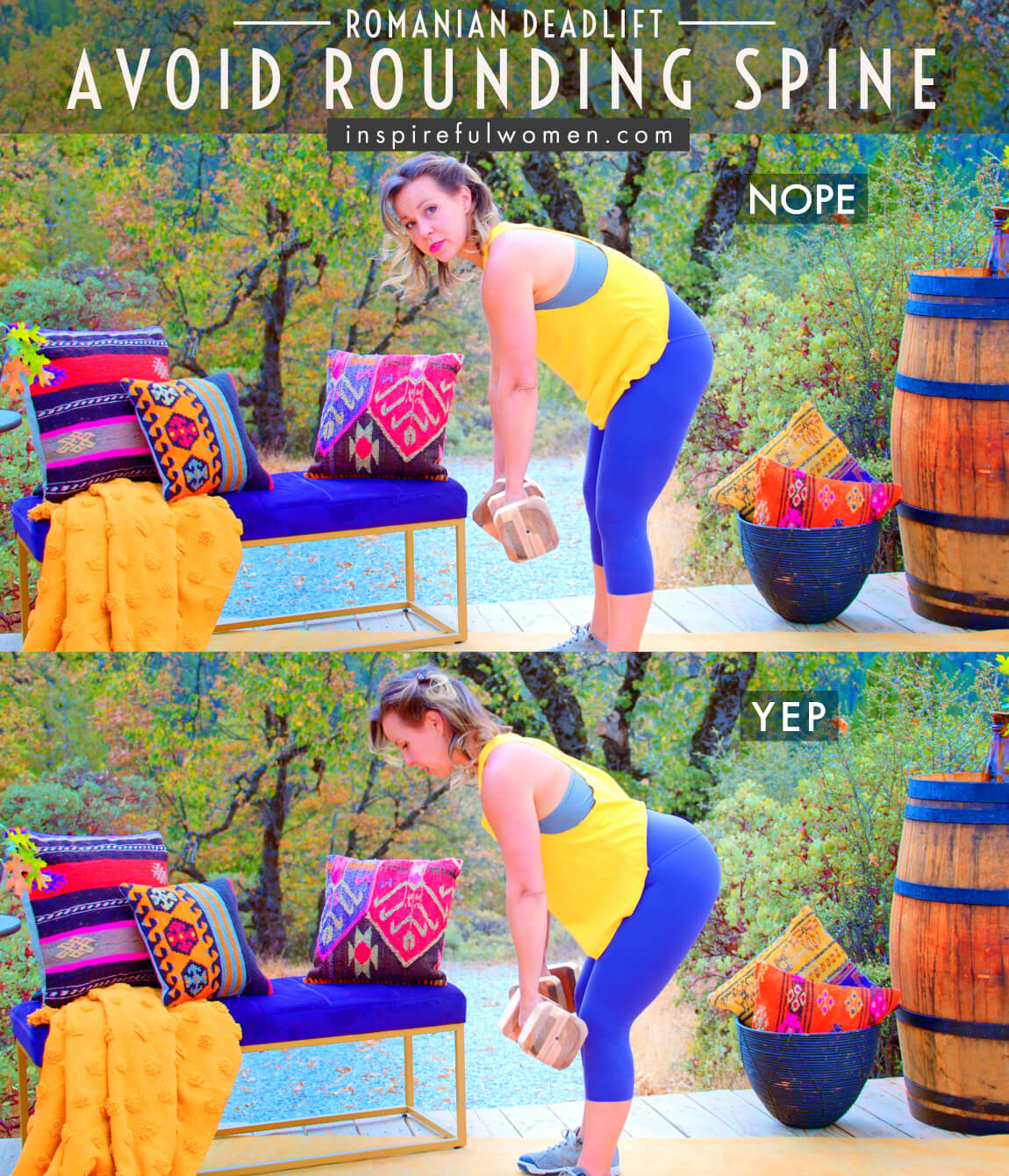
2. Avoid Shallow Hip Hinge
AVOID: Avoid not hinging with hips far enough.
WHY NOT?
- Not hinging far enough could increase the strain on the shoulders and low back.
- May cause you to have to squat too far, using more quadriceps and less hip extensors.
WHAT TO DO:
- The hips should be between the height of the shoulders and the knees.
- The hands should be directly under the shoulders throughout the exercise.
- If you cannot hinge far enough forward because your hamstrings are tight - try stretching them before the exercise.
- If you still cannot hinge far enough forward - work on hip hinging before doing the deadlift.
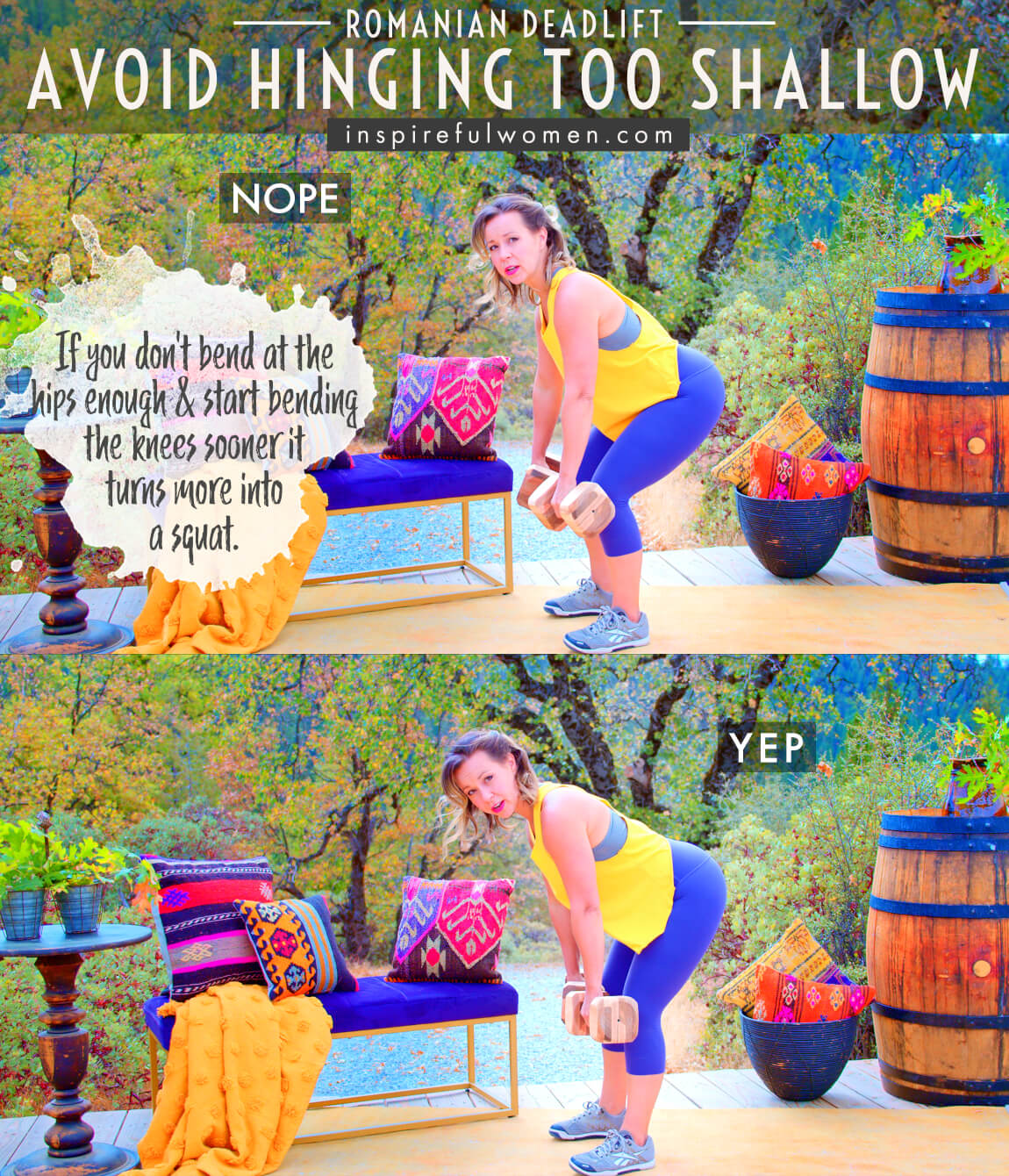
3. Avoid Pelvic Tilt
AVOID: Avoid doing a pelvic tilt at the top of the movement when extending your hips.
WHY NOT?
- The goal of this exercise is to train the gluteus maximus and hamstring to pull the leg backward relative to the pelvis.
- Moving the pelvis is movement of the spine - this can irritate the joints and muscles over time.
WHAT TO DO:
- Do not make the mistake of substituting this movement of the pelvis for movement of the hip - the thigh bone in the socket of the pelvis.
- At the end of the hip extension, use the gluteus maximus to extend the leg in the socket of the pelvis but do not tilt your pelvis.
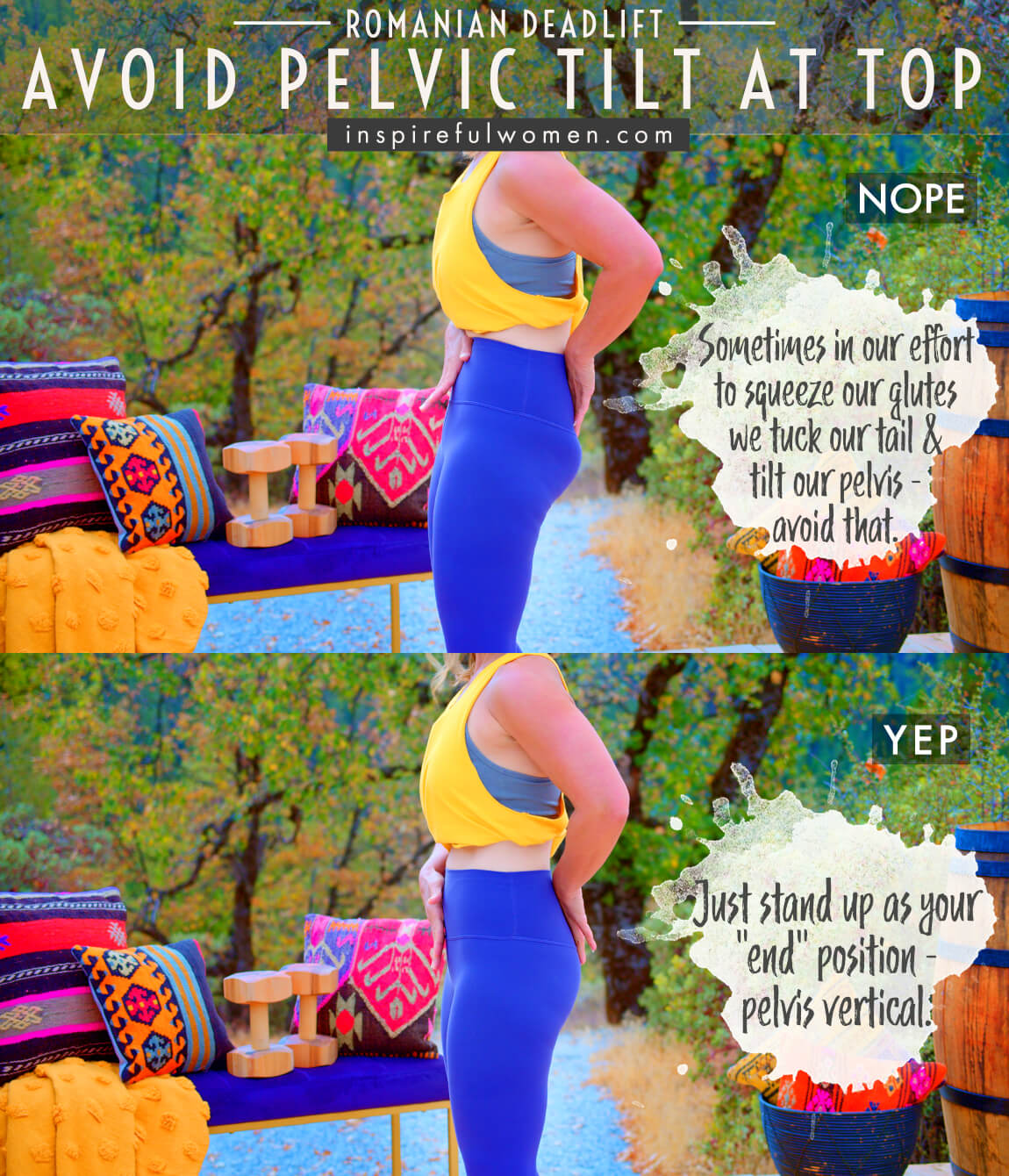
4. Avoid Pushing Hips Forward
AVOID: Avoid pushing your hips too far forward at the top of the movement.
WHAT TO DO:
- At the top of the movement, your back should be neutral, not arching.
- Sometimes people will push the hips too far forward so that the shoulders are behind the hips.
- Push the hips forward only until the shoulders are stacked over the hips.
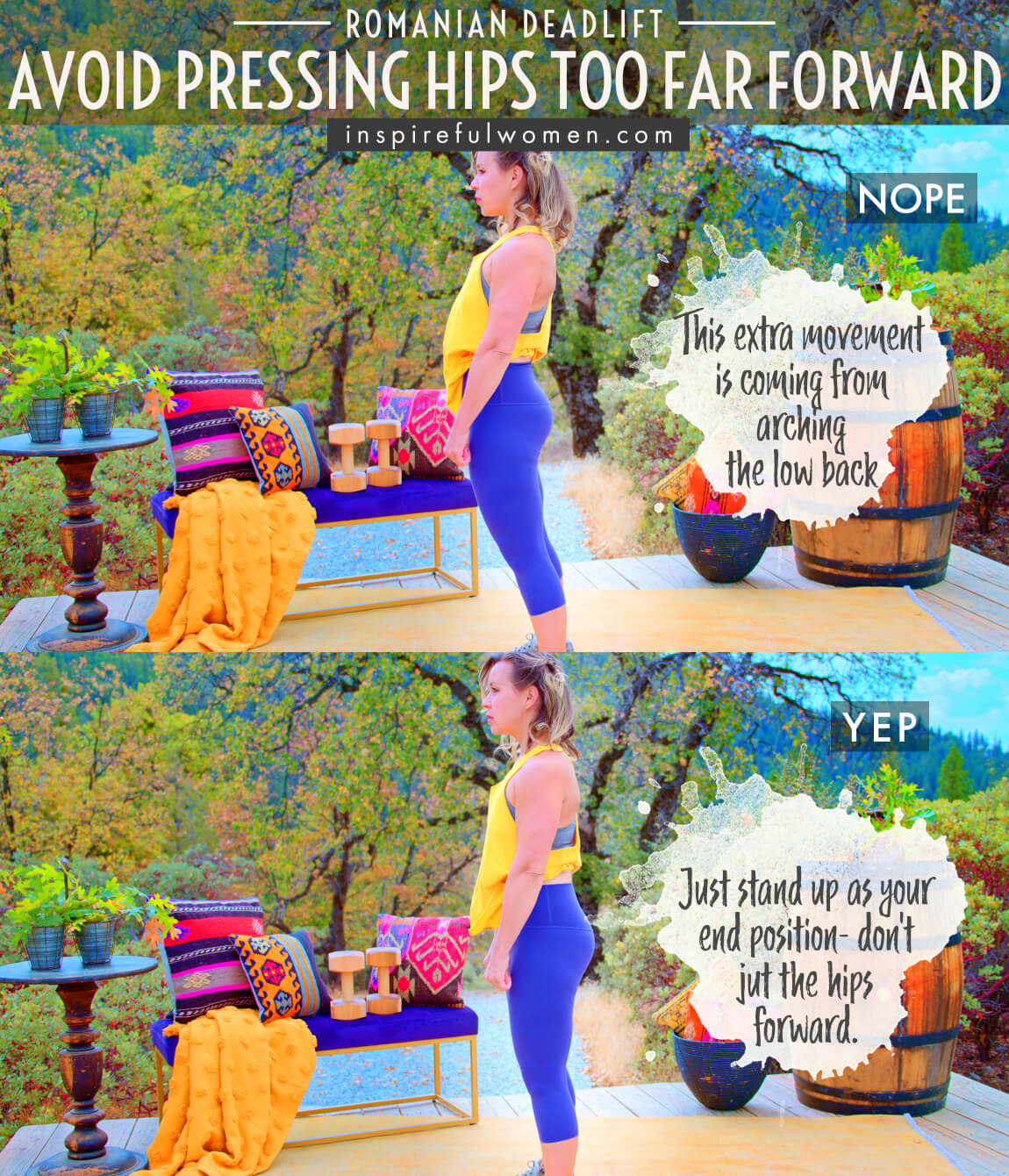
5. Avoid Lifting Chin
AVOID: Avoid lifting your chin as you hinge.
WHY NOT?
- This can cause a neck strain.
WHAT TO DO:
- Remember that your neck is part of your spine.
- Deadlifts do strengthen the neck muscles when you lean over.
- Keep the entire spine in neutral to strengthen the muscles in the healthiest position.
- Looking slightly down during the entire range of motion may help to keep the neck in neutral.
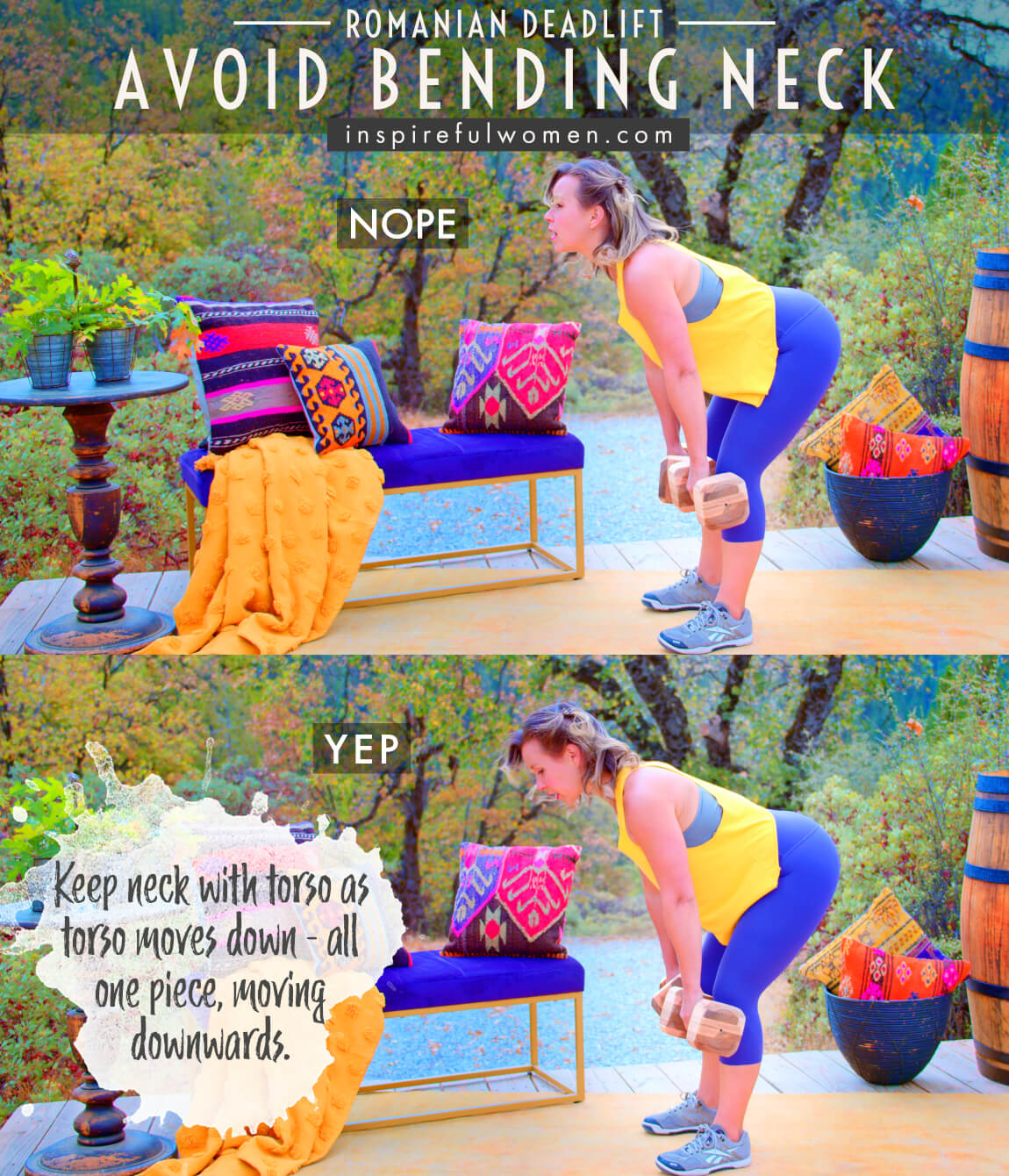
6. Avoid Rolling Forward To The Balls Of The Foot
AVOID: Rolling forward onto the ball of the foot.
WHY NOT?
- This happens when you have tight calf muscles (gastroc, soleus).
- This can also happen if you have restrictions in the mobility of your ankle joints
- Work on lifting your toes up off of the floor when the foot is flat on the floor
- Do this in sitting when the knee is bent and in standing when the knee is straight.
- This can put too much strain on the knee joint.
- The quadriceps will do more of the work.
WHAT TO DO:
- Try stretching your calf muscles.
- Put a lift under your toes to get your weight back.
- Make sure the weight is close to your body and not pulling you forward.
- Set your weights on elevated objects (placed on the sides of your legs), so that you don’t have to bend down as far.
- Do Romanian Deadlifts until you have improved the flexibility of your ankles.
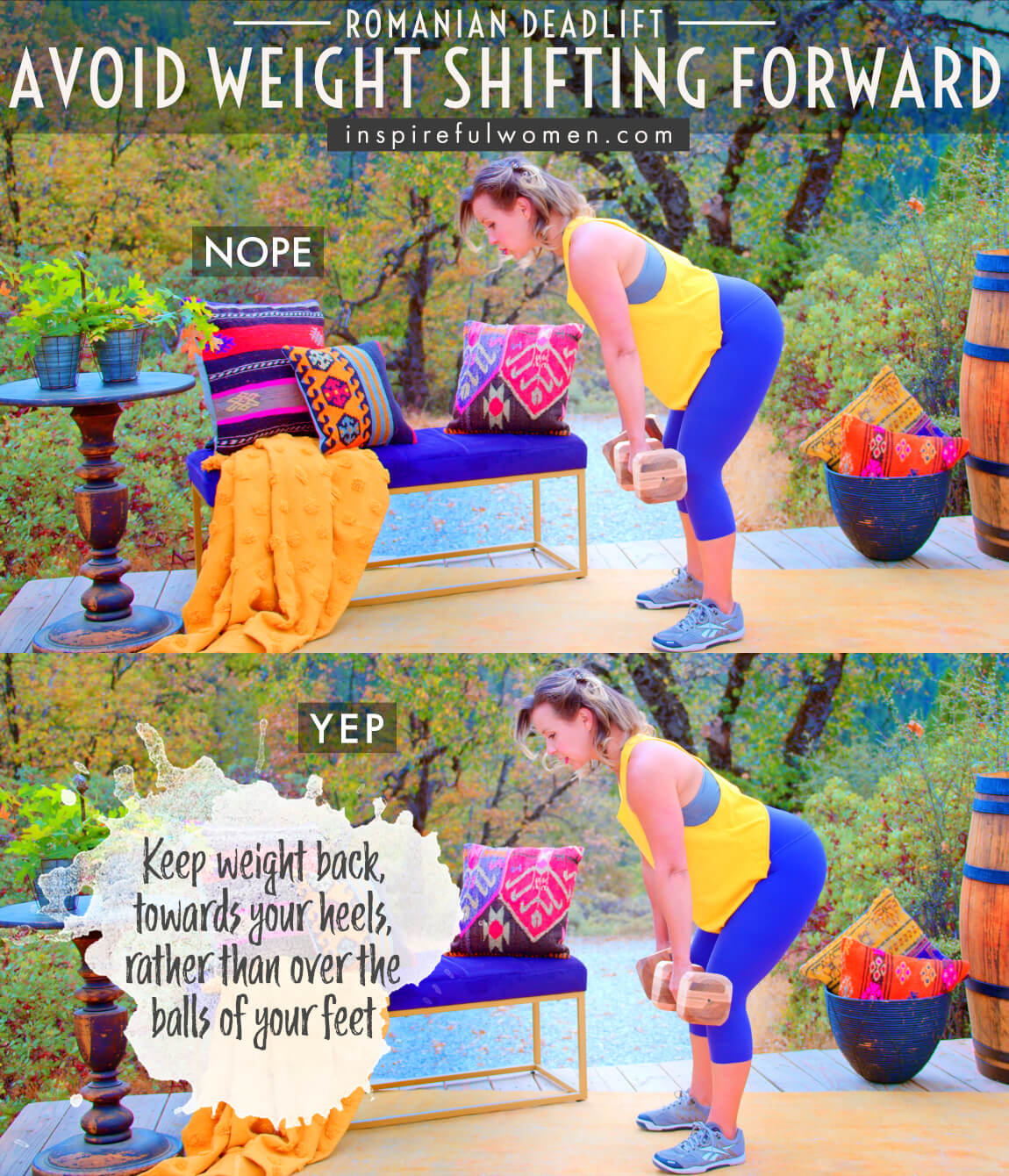
7. Avoid Locking Knees
AVOID: Hyperextending or locking the knees at the top of the movement
WHY NOT?
- This puts too much strain on the knee joints, using the ligaments and joint surface to stabilize the joint.
WHAT TO DO:
- The legs will straighten as you stand up tall, but the knees should be soft - not locked back.
- Keep the knee soft to protect the joint and also to keep the leg muscles engaged.
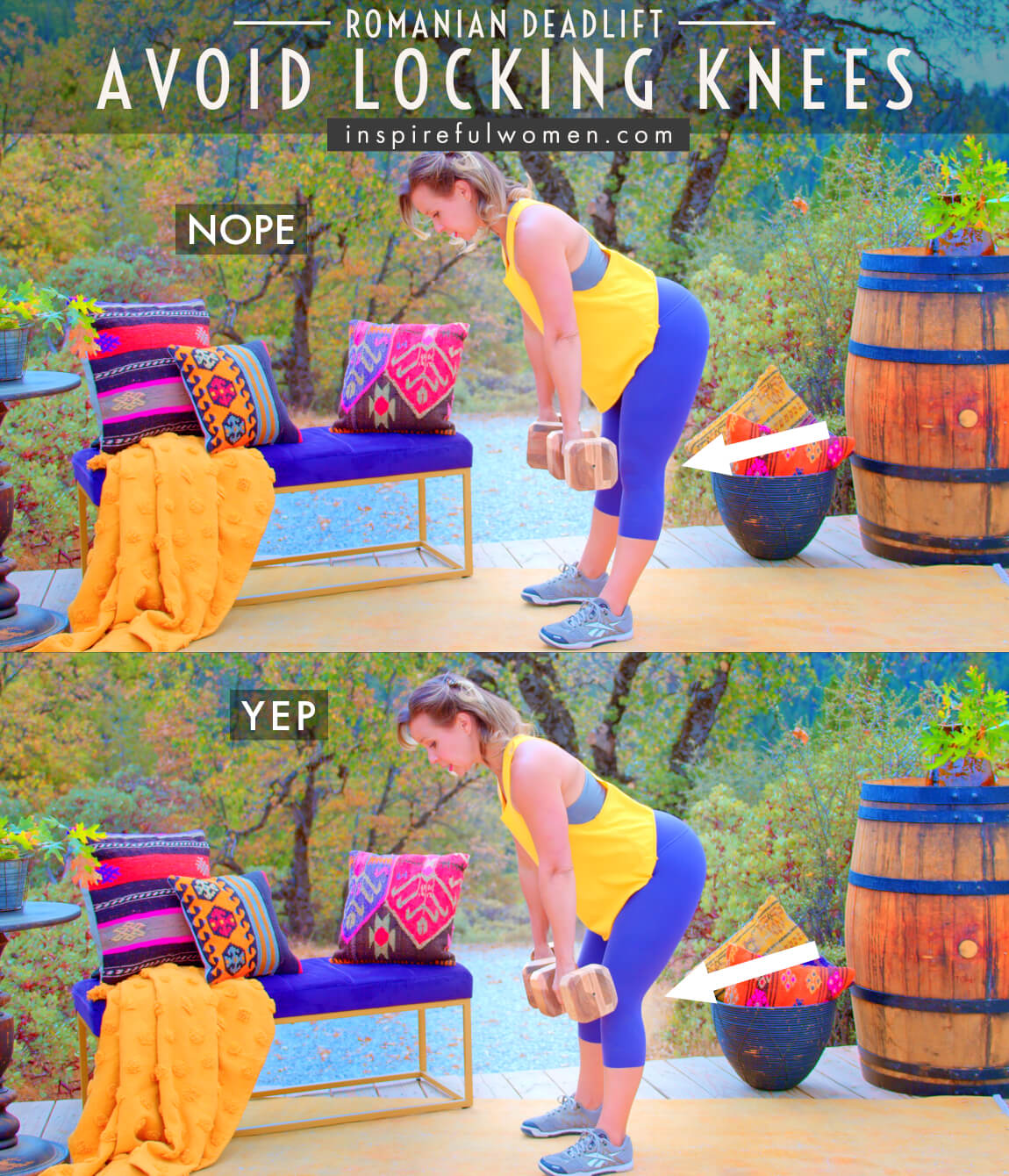
8. Avoid knees Caving In/out
AVOID: Letting the feet or knees lean in or out
WHAT TO DO:
- Keep the ankles and knees aligned during the exercise.
- The knees should travel over the second and third toe as you lower down and lift the weight.

VARIATIONS
VARIATIONS
VARIATIONS OF Romanian Deadlifts
with Kettlebell
Kettlebell Romanian Deadlift
1 Kettlebell between the feet: grab the handle with both hands.
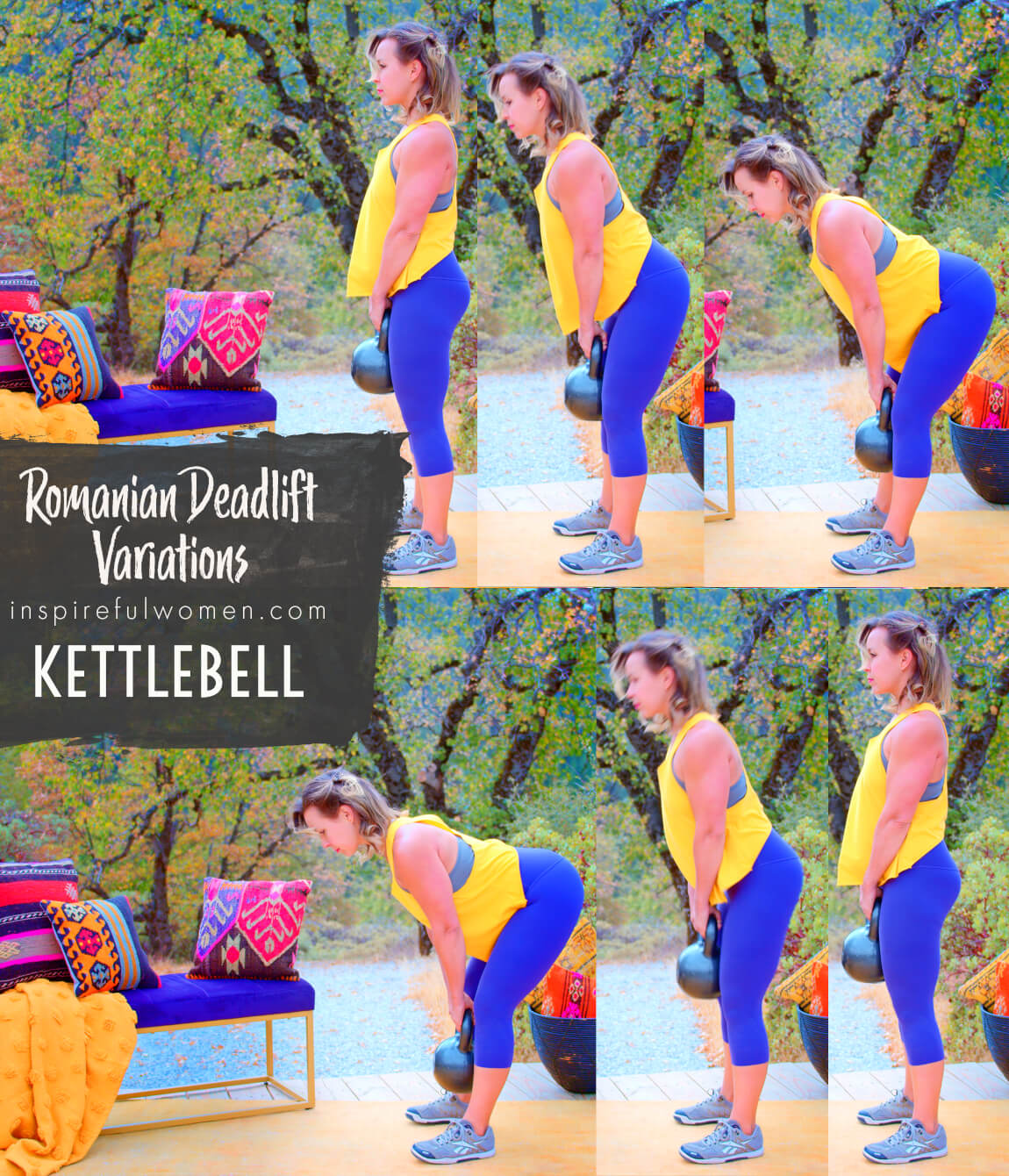
one dumbbell
1 dumbbell romanian deadlift
1 Dumbbell held by one hand on each end: the dumbbell will be horizontal and positioned between the feet.

placement of dumbbells
Placement of Dumbbells
2 Dumbbells: Place the dumbbells in front of the toes, or with the handle over the toes of each foot. The dumbbell will be perpendicular to the foot. Grip: When you bend down, pick up the weights with your palms facing your legs, the thumbs will be on the insides.
- For this variation: if your range of motion in your ankles or knees, or your leg strength does not allow you to lower the weights all the way to the floor then you can hold the weights throughout the movement - lowering the hands to below the knees but never touching them down to the floor.
Holding the weights by the sides of the feet: This will shift the load back. This will decrease the demand on the hip extensors (hamstrings and gluteus maximus) and the back extensors, and work the quadriceps more.
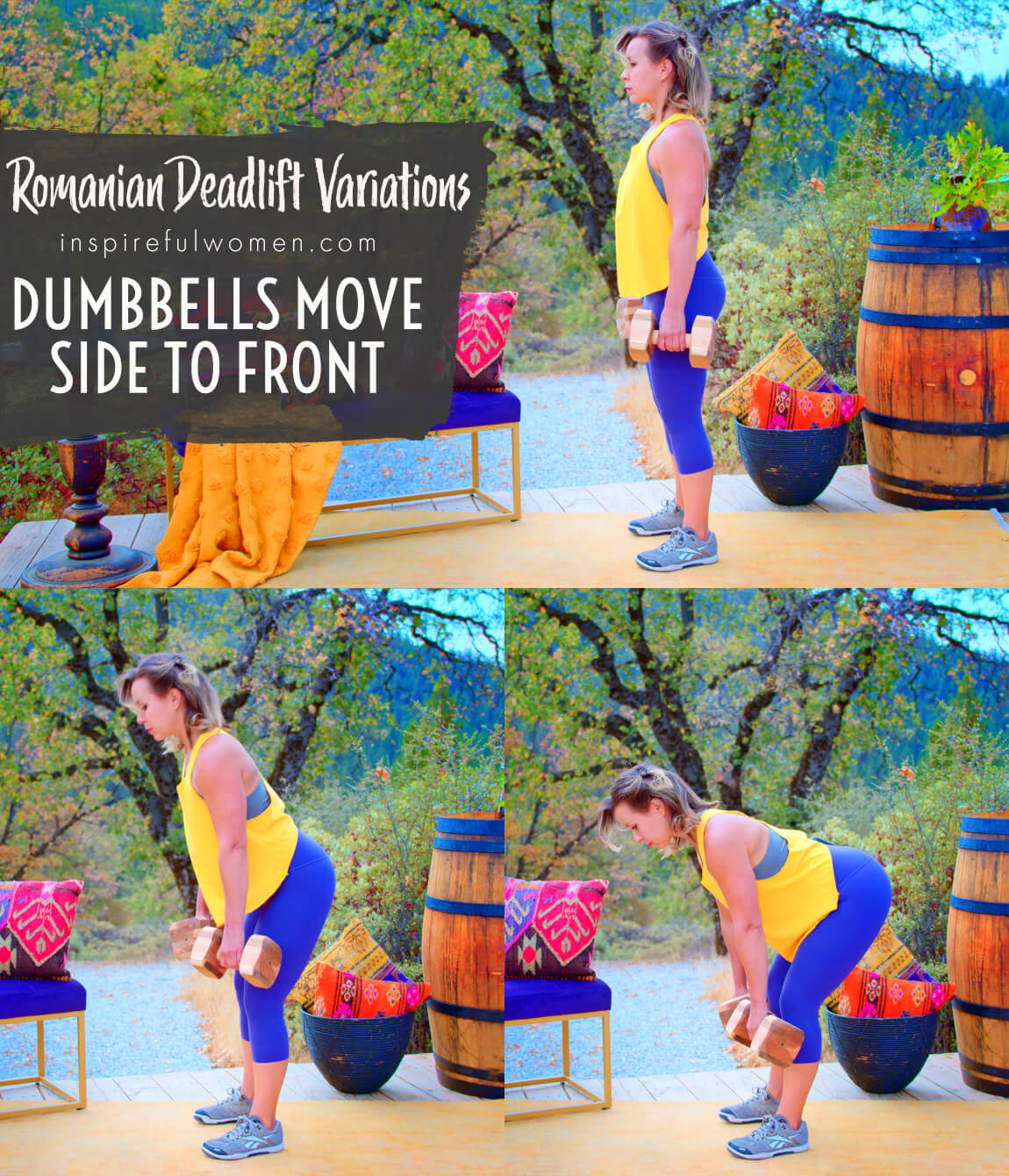
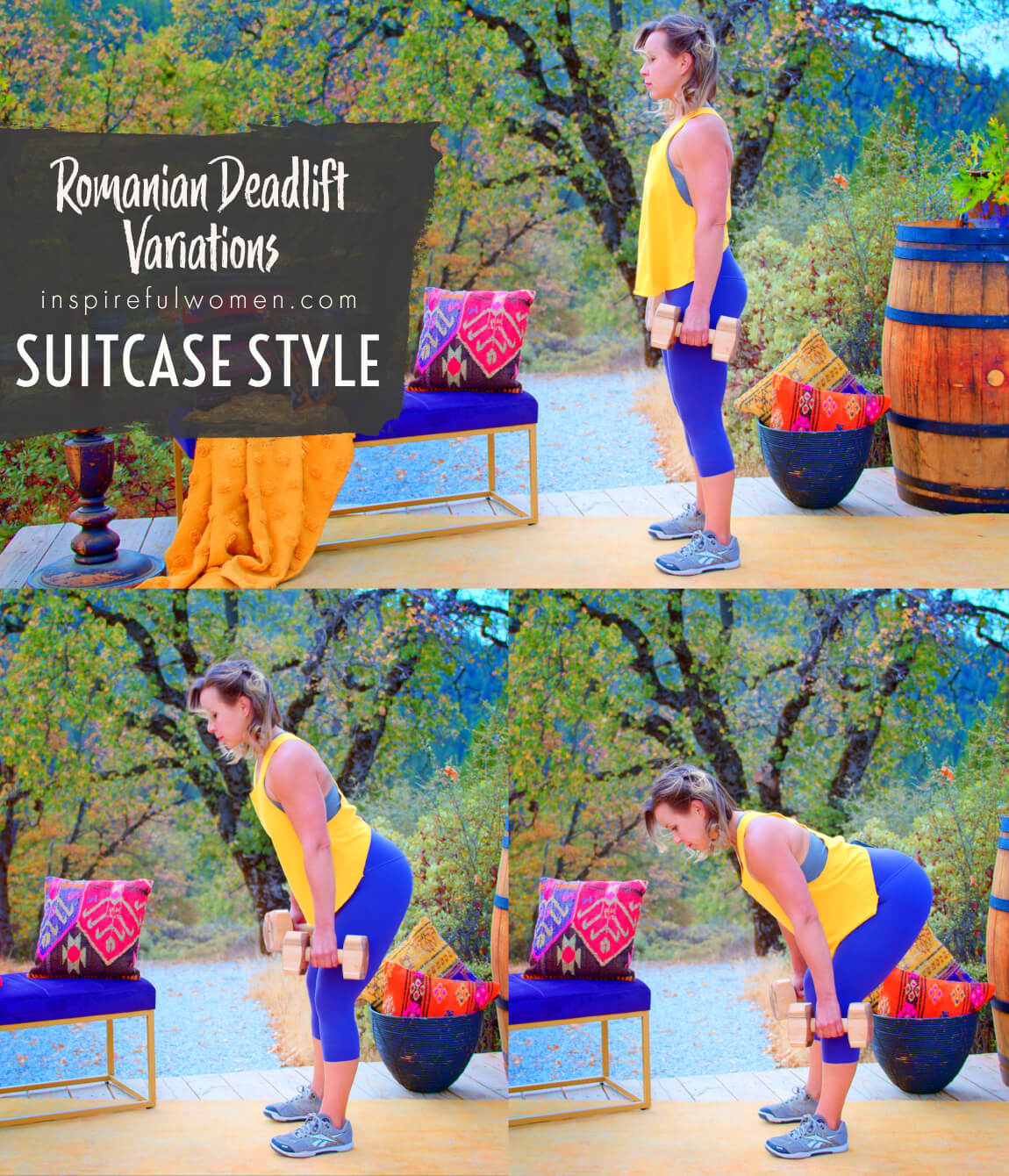
WHAT WE'RE DOING TODAY
WHAT & WHY
BENEFITS OF TRAINING THE POSTERIOR CHAIN MUSCLES
WHAT
TRAINING FOR SOMETHING WE DO EVERYDAY
There are 2 main ways we safely lift heavy things from the floor - squatting & deadlifting.
With both of these positions, the goal is to maintain a neutral spine, moving from the hips and knees not from the back, and having the load as close as possible to your body.
In both of these lifts the weight is lifted from a position close to the feet. When you lift from the floor the load needs to be close to your body. A squat requires more calf length (not tight), knee and hip range of motion and good core strength. Doing a squat with good form helps to work on all of this, but you will be limited in adding resistance because if you add resistance - first your form has to be perfect. If you are limited in these areas but you want to work on increasing your strength then the deadlift could be an option.
Deadlifts are basically lifting a heavy object from the floor. It is a movement that we do all day long lifting children and other heavy items like groceries and laundry. The exercise begins with hinging at the hips. The core muscles are working to hold the spine in neutral. Once the hips are hinged forward, the weight is lifted up using the leg muscles. A benefit of the deadlift is that with good form you should be able to lift quite a bit of weight. What this means is that you might want to eventually invest in some heavier dumbbells or a heavy kettlebell for these. We have 3 very large sets of muscles (quads, hamstrings & glutes) helping out in this exercise (and remember there's 2 of each!) so they can move a lot of weight working all together. And you are not working them through a very big range of motion.
Additionally, it is much easier to do a deadlift than a squat with correct form - easier to keep the spine in neutral because the hip flexion is not as great as a squat. And the muscles are at a length where they are stronger (length-tension curve). Making it a good choice for really working the muscles of the arms, core, and legs. But, it is essential to lift the heavy weight with proper form to avoid hurting your back.
IT’S ALL ABOUT THE HIP HINGE
The main movement in this exercise is hip hinging, leaning over from the hips (where the hips crease) and then using the hip extensors (gluteus maximus and hamstrings) to straighten the hips/stand back up. It seems like a simple movement but it is often performed with very poor form. Many people bend their backs instead of hinging at the hips. With this approach, the back muscles are trying to lift the heavy weight instead of the larger and more powerful leg muscles, this form can end up really straining the low back.
WHY BOTHER DOING IT?
WHY
WHY DO WE EVEN CARE?
STRONG BACKSIDES = HEALTHY BACK, HIPS & KNEES
Strong hamstrings and glutes are needed to keep the back, hips, and knees healthy. They work with all of the other muscles of the core and legs to keep the joints aligned and cushion the impact, and they do this while we move our bodies in various ways and with various amounts of weight or resistance.
FOCUS ON CREATING STRONG, POWERFUL STRIDES & LOWER BODY MOVEMENT IN EVERYDAY LIFE
Hamstring exercises often focus on movements that bend the knees, like hamstring curls, to target the hamstrings. The problem with this is that one of the important jobs of the hamstrings is to pull the hip back (extension) - this is when you go from for instance standing, to taking a step forward, the trailing leg/back leg, is now in “extension” - from the hip joint, your leg is behind you. In fact this function is how we use our hamstrings most throughout the day - for walking, running, getting up from a chair, and climbing stairs. Deadlifts are a really good way to train the hamstrings in coordination with the gluteus maximus to pull the hip back from a bent position.
In order to lift properly we need 1). strong legs, 2). core strength to stabilize the spine in a neutral position, and 3). mobility in our hips.
Learning how to do deadlifts with proper form will help us with the first two:
build the leg and core strength needed to improve the way that you lift during your daily activities. Good posture and body mechanics, along with strong leg and core muscles and joint mobility will lessen the damage to the joints of the lumbar spine and hips from degenerative changes that occur with age.
LEARN PROPER BACK POSITION WHEN LIFTING STUFF WITH THIS EXERCISE
Chances are good that you will experience back pain at some time in your life. It makes sense to learn to use the body as it is designed to be used. The legs are designed for strength and power.
The back is designed to keep us upright and to provide a base of support for the legs and arms to move from, the back is not designed for heavy lifting. The back plays more of supportive stabilizing role in heavy lifting, like with the deadlift, the legs are doing the standing back up with the heavy weight, and the back and arms are working in a supportive role to stabilize oneself while holding that heavy weight.
Learning the correct way to lift heavy items from the floor, and strengthening the leg muscles can help to prevent back injuries and damage to the small joints of the spine that can happen due to poor lifting technique. One key to keeping your back healthy is to keep your legs strong so they can do the heavy lifting, decreasing the strain on the back.
This is an excellent exercise when it is performed correctly but can cause back injury when the form is incorrect.
*** special caution with osteoporosis, spondylolisthesis, spondylolysis or history of disc pathology.
EVERYDAY LIFE
EVERYDAY LIFE &
MUSCLE FUNCTION
HOW WE USE OUR POSTERIOR CHAIN MUSCLES IN EVERYDAY LIFE
1. STRAIGHTENING (EXTENSION) THE HIPS AND KNEES
- Standing from a sitting position
- Walking up stairs
- Lifting an item off of the floor
- Climbing a ladder
- Walking uphill
- Getting up from the floor
SCIENCY STUFF
SCIENCY STUFF
SPIFFILICIOUS FACTS ABOUT MUSCLES & MOVES
The legs are designed for strength and power. What shows us this is the case? The design of the muscle - the shape, orientation, location - origin and insertion points, size (length and bulk), and muscle fiber type. Take the quadriceps muscle for example - all four muscles join at a shared tendon which has the patella embedded in it. The patella acts as a pulley system - making the muscle capable of very large forces.
Compare that with the erector spinae - which is really a lot of different sections of muscle that attach on the vertebrae spanning a few segments at a time - they are fairly short muscles and they overlap from the neck to the pelvis - the layer upon layer provides support, not a lot of movement - especially at each individual segment, and the muscle type is more aerobic - designed for endurance, they can’t handle the heavy lifting.
Bending forward at the spine and lifting heavy items, especially if you are slightly rotated during the movement, can lead to damage to the discs in the spine. Why is this? It has a lot to do with the design of the discs -the way the collagen fibers of the discs are arranged in a crisscross pattern with the bottom part attached to the vertebra below. When you rotate only half of the fibers will become taut, and the other half (which are oriented diagonally in the other direction) will be relaxed. This provides only 50% of the structural support, making it more vulnerable to injury.
1. The position stretches some of the supporting ligaments to their end range, there is a weak area in the back on each side. Bending compresses the discs in the front and causes the nucleus to be pushed to the back - pushing it back toward the weak area. This is how a herniated or bulging disc occurs.
2. There are two facet joints which are made up of the small bony protrusions off of each vertebra - for example, L4 and L5 both have little bony parts sticking off of the sides of the vertebrae - these for the facet joints between L4-5. When you rotate you lock out the joint - where the joint is most compressed. It is easier to irritate the joint in this position.
The back is designed to keep us upright and to provide a base of support for the legs and arms to move from, the back is not designed for heavy lifting. So the back plays more of a supportive stabilizing role in heavy lifting then- like with the deadlift, the legs are doing the standing back up with the heavyweight, and the back and arms are working in a supportive role to stabilize oneself while holding that heavy weight.
Kind of like using a lever to lift something - you put a crowbar under something and push down on one end. The spine is like the crowbar. If it was not strong enough to lift the support the object as you push down with your arm then it will bend, or break.
ALLLL MUSCLES & WHEN
ALL MUSCLES WORKING & WHEN DURING THE Romanian Deadlift
The muscles of the arms and hands are working to hold the weights. The gluteus maximus, hamstrings, and adductor magnus work eccentrically as the torso moves from vertical to horizontal. The muscles of the back work to stabilize the spine. The leg muscles are working to hold the legs upright as the weights pull forward.
As the trunk moves from vertical to horizontal the hamstrings are lengthened over the back of the leg. Once the hamstrings are at their limit, the gluteus maximus and hamstrings quickly contract concentrically to pull the hips back into a neutral position.
PIN IT FOR LATER!
